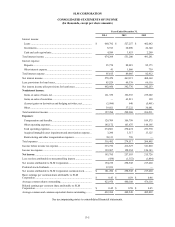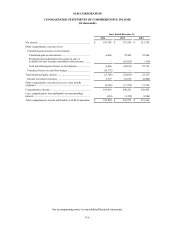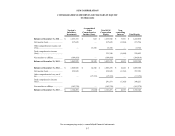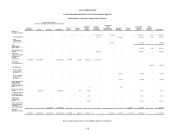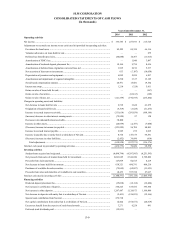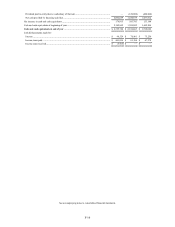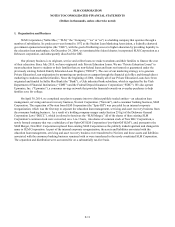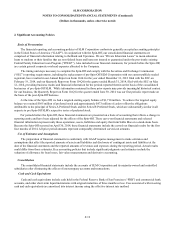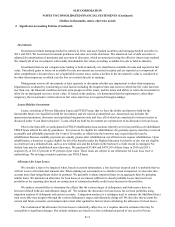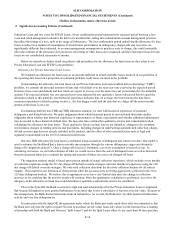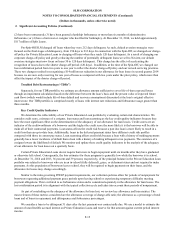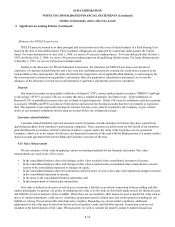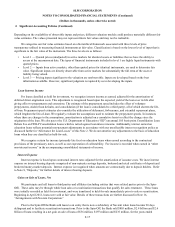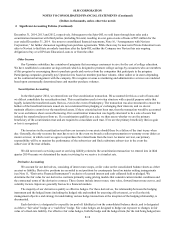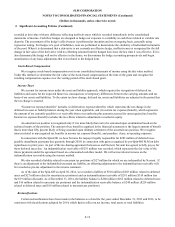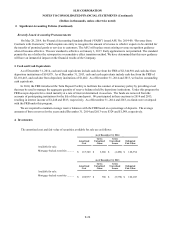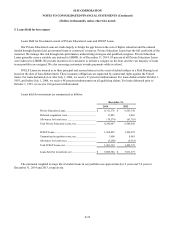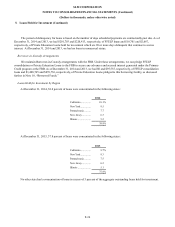Sallie Mae 2014 Annual Report Download - page 99
Download and view the complete annual report
Please find page 99 of the 2014 Sallie Mae annual report below. You can navigate through the pages in the report by either clicking on the pages listed below, or by using the keyword search tool below to find specific information within the annual report.SLM CORPORATION
NOTES TO CONSOLIDATED FINANCIAL STATEMENTS (Continued)
(Dollars in thousands, unless otherwise noted)
2.
Significant Accounting Policies (Continued)
(2) have been restructured; (3) have been granted a hardship forbearance or more than six months of administrative
forbearance; or (4) have a borrower or cosigner who has filed for bankruptcy. At December 31, 2014, we held approximately
$117 million of Split Loans.
Pre-Spin-Off SLM charged off loans when they were 212 days delinquent. As such, default aversion strategies were
focused on the final stages of delinquency, from 150 days to 212 days. In connection with the Spin-Off, we changed our charge-
off policy for Private Education Loans to charging off loans when they reach 120 days delinquent. As a result of changing our
corporate charge-off policy and greatly reducing the number of potentially delinquent loans we sell to Navient, our default
aversion strategies must now focus on loans 30 to 120 days delinquent. This change has the effect of accelerating the
recognition of losses due to the shorter charge-off period (120 days). In addition, at the time of the Spin-Off, we changed our
loss confirmation period from two years to one year to reflect the shorter charge-off policy and our revised servicing practices.
These two changes resulted in recognizing a $14 million net reduction in our allowance for loan losses in second quarter 2014
because we are now only reserving for one year of losses as compared with two years under the prior policy, which more than
offset the impact of the shorter charge-off period.
Troubled Debt Restructurings (“TDRs”)
Separately, for our TDR portfolio, we estimate an allowance amount sufficient to cover life-of-loan expected losses
through an impairment calculation based on the difference between the loan’s basis and the present value of expected future
cash flows (which would include life-of-loan default and recovery assumptions) discounted at the loan’s original effective
interest rate. Our TDR portfolio is comprised mostly of loans with interest rate reductions and forbearance usage greater than
three months.
Key Credit Quality Indicators
We determine the collectability of our Private Education Loan portfolio by evaluating certain risk characteristics. We
consider credit score, existence of a cosigner, loan status and loan seasoning as the key credit quality indicators because they
have the most significant effect on the determination of the adequacy of our allowance for loan losses. Credit scores are an
indicator of the creditworthiness of a borrower and the higher the credit score the more likely it is the borrower will be able to
make all of their contractual payments. Loan status affects the credit risk because a past due loan is more likely to result in a
credit loss than an up-to-date loan. Additionally, loans in the deferred payment status have different credit risk profiles
compared with those in current pay status. Loan seasoning affects credit risk because a loan with a history of making payments
generally has a lower incidence of default than a loan with a history of making infrequent or no payments. The existence of a
cosigner lowers the likelihood of default. We monitor and update these credit quality indicators in the analysis of the adequacy
of our allowance for loan losses on a quarterly basis.
Certain Private Education Loans do not require borrowers to begin repayment until six months after they have graduated
or otherwise left school. Consequently, the loss estimates for these programs is generally low while the borrower is in school.
At December 31, 2014 and 2013, 36 percent and 39 percent, respectively, of the principal balance in the Private Education Loan
portfolio was related to borrowers who are in an in-school (fully deferred), grace, or deferment status and not required to make
payments. As this population of borrowers leaves school, they will be required to begin payments on their loans, and the
allowance for losses may change accordingly.
Similar to the rules governing FFELP payment requirements, our collection policies allow for periods of nonpayment for
borrowers requesting additional payment grace periods upon leaving school or experiencing temporary difficulty meeting
payment obligations. This is referred to as forbearance status and is considered separately in the allowance for loan losses. The
loss confirmation period is in alignment with the typical collection cycle and takes into account these periods of nonpayment.
As part of concluding on the adequacy of the allowance for loan loss, we review key allowance and loan metrics. The
most relevant of these metrics considered are the allowance coverage of charge-offs ratio; the allowance as a percentage of total
loans and of loans in repayment; and delinquency and forbearance percentages.
We consider a loan to be delinquent 31 days after the last payment was contractually due. We use a model to estimate the
amount of uncollectible accrued interest on Private Education Loans and reserve for that amount against current period interest
income.
F-15


